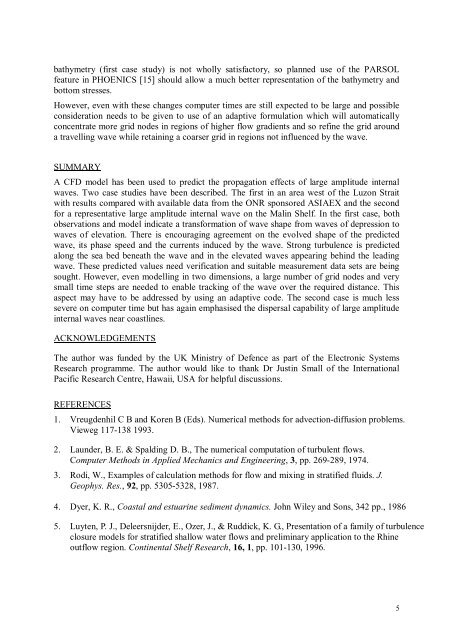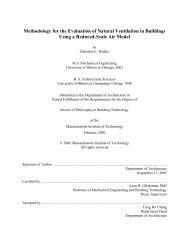DSTL (PDF) - Cham
DSTL (PDF) - Cham
DSTL (PDF) - Cham
You also want an ePaper? Increase the reach of your titles
YUMPU automatically turns print PDFs into web optimized ePapers that Google loves.
athymetry (first case study) is not wholly satisfactory, so planned use of the PARSOLfeature in PHOENICS [15] should allow a much better representation of the bathymetry andbottom stresses.However, even with these changes computer times are still expected to be large and possibleconsideration needs to be given to use of an adaptive formulation which will automaticallyconcentrate more grid nodes in regions of higher flow gradients and so refine the grid arounda travelling wave while retaining a coarser grid in regions not influenced by the wave.SUMMARYA CFD model has been used to predict the propagation effects of large amplitude internalwaves. Two case studies have been described. The first in an area west of the Luzon Straitwith results compared with available data from the ONR sponsored ASIAEX and the secondfor a representative large amplitude internal wave on the Malin Shelf. In the first case, bothobservations and model indicate a transformation of wave shape from waves of depression towaves of elevation. There is encouraging agreement on the evolved shape of the predictedwave, its phase speed and the currents induced by the wave. Strong turbulence is predictedalong the sea bed beneath the wave and in the elevated waves appearing behind the leadingwave. These predicted values need verification and suitable measurement data sets are beingsought. However, even modelling in two dimensions, a large number of grid nodes and verysmall time steps are needed to enable tracking of the wave over the required distance. Thisaspect may have to be addressed by using an adaptive code. The second case is much lesssevere on computer time but has again emphasised the dispersal capability of large amplitudeinternal waves near coastlines.ACKNOWLEDGEMENTSThe author was funded by the UK Ministry of Defence as part of the Electronic SystemsResearch programme. The author would like to thank Dr Justin Small of the InternationalPacific Research Centre, Hawaii, USA for helpful discussions.REFERENCES1. Vreugdenhil C B and Koren B (Eds). Numerical methods for advection-diffusion problems.Vieweg 117-138 1993.2. Launder, B. E. & Spalding D. B., The numerical computation of turbulent flows.Computer Methods in Applied Mechanics and Engineering, 3, pp. 269-289, 1974.3. Rodi, W., Examples of calculation methods for flow and mixing in stratified fluids. J.Geophys. Res., 92, pp. 5305-5328, 1987.4. Dyer, K. R., Coastal and estuarine sediment dynamics. John Wiley and Sons, 342 pp., 19865. Luyten, P. J., Deleersnijder, E., Ozer, J., & Ruddick, K. G., Presentation of a family of turbulenceclosure models for stratified shallow water flows and preliminary application to the Rhineoutflow region. Continental Shelf Research, 16, 1, pp. 101-130, 1996.5
















